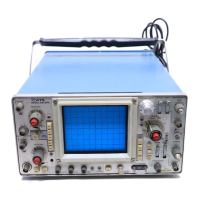TM 11-6625-2735-14-1
Obtaining Replacement Parts
Refer to Repair Parts and Special Tools List TM 11-6625-
2735-24P-1 for correct part number and identification.
Soldering Techniques
Always disconnect the instrument from the power
source before attempting to solder in the instrument.
Ordinary 60/40 solder and a 15-to 40-watt pencil-type
soldering iron can be used to accomplish the majority of
the soldering to be done in the 475. If a higher wattage-
rating soldering iron is used on the etched circuit boards,
excessive heat can cause the etched circuit wiring to
separate from the board base material.
The Vertical Preamplifier Attenuator circuit boards
are made of material easily damaged by excessive
heat. When soldering to these boards, do not use a
soldering iron with a rating of more than ap-
proximately 15 watts. Avoid prolonged applications
of heat to circuit-board connections. Use only
isopropyl alcohol when cleaning this circuit board.
The following technique should be used to replace a
component on a circuit board. Most components can be
replaced without removing the boards from the instru-
ment.
1. Grip the component lead with long-nose pliers.
Touch the soldering iron to the lead at the solder
connection. Do not lay the iron directly on the board, as it
may damage the board.
2. When the solder begins to melt, pull the lead out
gently. If unable to pull the lead without using force, try
removing the other end of component as it may remove
easier.
NOTE
The reason that some component leads seem
troublesome to remove
IS due to a bend placed on
each lead during machine insertion of the compo-
nent in the circuit-board manufacturing process.
The purpose of the bent leads is to hold the
component in place during a flow-soldering,
manufacturing process that solders all components
at once.
If a component lead is extremely difficult to remove, it
may be helpful to straighten the leads on the back side of
the board with a small screwdriver or pliers while heating
the soldered connection.
Desolder the component from the circuit board using
heat on the component lead so that the solder will stay
behind on the board. If it is desired to remove solder from a
circuit board hole for easier installation of a new compo-
nent, a vacuum-type resoldering tool or a solder-
removing wick should be used for this purpose.
4-19

